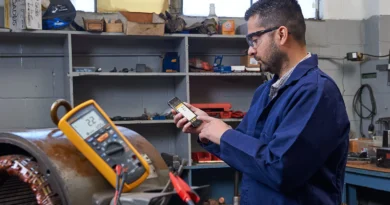Silicone Painting Operator ( 6 Month Diploma )

Silicone Painting Operator: The Silicone Painting Operator applies the
silicone paint to the resistor for colour coding.
Brief Job Description: The individual at work is responsible for applying the
silicone paint to the resistor by either automated or manual method, drying it
for few hours and baking in oven to make it permanent.
Personal Attributes: The job requires the individual to have: attention to
details, good eyesight and visual accuracy and ability to work for long hours
generally in a standing position.
Apply silicone paint to the resistors
Description
This OS unit is about applying silicone paint to the resistors by automated or manual
method, ensuring resistance to high humidity, corrosion and heat for high
temperature applications, drying and baking in oven for permanent paint
Scope
This unit/task covers the following:
Understand the work requirement

Program the paint application machine for automated system
Apply silicone paint to the resistor
Send the painted resistor through oven
Perform post painting finishing and storing
Check visually the coated resistors
Undertake preventive maintenance of machine and equipment
Achieve productivity and quality standards
Performance Criteria Understanding work requirement
To be competent, the user/individual on the job must be able to:
collect the resisters and consumables required for painting
record the number of resister or lots received
read the job sheet and match the value for the lot received
determine the quantity to be painted, production time, stock specifications,
and colour code sequence according to job sheet
Programming the paint application machine
To be competent, the user/individual on the job must be able to:
program the coat thickness and the number of coatings to be applied
program the flow rates and material viscosity to the applicator for the
thickness to be maintained
load new values for different lots
Applying silicone paint to resistor manually or using machine
To be competent, the user/individual on the job must be able to:
measure and mix the quantities of heat resistant paint and thinner
add thinner as specified for the number of dips
apply paint on the resistor
for automated painting, attach and align machine parts such as rollers,
guides, brushes, blades – using hand tools
fill the machine with the heat resistant paint and thinner as per specifications
dip the resistor in one direction and then in the other until specified thickness
of coating is achieved
apply paint at slow speed to ensure even paint coverage, alignment, and
adhesion
check visually for errors and rework
dry the coat in air for up to 30 minutes
Baking resistor through oven
To be competent, the user/individual on the job must be able to:
bake the painted resistor in oven for specified hours at different temperatures
set specified temperature for each stage of oven bake
set specified time for pre-heating and baking
follow specified baking schedule for single or multi coat
Performing post painting finishing
To be competent, the user/individual on the job must be able to:
.coat painted resister with silicone varnish for a glossy finish and dry
transfer painted and varnished resisters from machine to storage area
Visual checking To be competent, the user/individual on the job must be able to:
check the painted resistor visually for paint clarity, colour accuracy and
external defects
examine, measure, weigh or test sample product to ensure conformance to
specifications Undertaking preventive maintenance
To be competent, the user/individual on the job must be able to:
clean machine, equipment and work area using water, solvents and other
cleaning aids
perform regular cleaning as prescribed by machine manufacturer
detect for any damage or defects and maintain machine to avoid downtime
perform weekly greasing and cleaning of nozzles
Achieving productivity and quality standards
To be competent, the user/individual on the job must be able to:
achieve the daily target number of resisters to be painted
ensure 100% standard paint colour and appearance
ensure colour permanence
achieve zero bubbles and pin holes, and even coating
achieve zero damage to resister during silicone painting process
deliver to the next stage in time
record production data as per job sheet
Organizational Context
The individual on the job needs to know and understand:
company’s policies on: incentives, delivery standards and personnel
management and Intellectual Property Rights (IPR)
work flow involved in production process of the company
importance of the individual’s role in the workflow
reporting structure
profile of clients
component stocking policy
safety and quality standards followed in the organization
Technical Knowledge
The user/individual on the job needs to know and understand:
. basic electronics and component identification
different types of paint application machines, their functions and controls
basic programming, setting up and loading the paint application machine
thickness and material viscosity of paints
baking techniques with temperature specifications
brush coat, dip coat and spray coat techniques
colour codes and polarity of components
regulation of operating speed and temperature of machine
consumables, painting process, quality control, costs
repair and maintenance of machines and tools
electro-static discharge (ESD) precautions
commonly occurring machine defects
Reading and Writing Skills
The user/individual on the job needs to know and understand how:
to maintain job sheets, logs and records
to operate computer
to read production schedules and operations manuals
to document the outcome of checks
Communication Skills
The user/individual on the job needs to know and understand how:
to effectively communicate with the supervisor on the process issues
to effectively communicate maintenance issues to the maintenance personnel
Team work and Multitasking
The user/individual on the job needs to know and understand how:
to be able to work on multiple machines at a time, as instructed
to work as a team and deliver on time to next work process
Professional Skills Reflective Thinking
The user/individual on the job needs to know and understand how:
to reduce repetitive errors
to improve work process
Analytical Thinking
The user/individual on the job needs to know and understand how:
to promptly to resolve problems
to enhance machine performance
Using Tools and Machines
The user/individual on the job needs to know and understand how:
to operate the paint machine
to use rollers, brush, sprayer, die, blades and guides for the painting
Critical Thinking
The user/individual on the job needs to know and understand how:
to spot process disruptions and delays
to interpret instructions furnished in written, oral or schedule form
Problem solving and Troubleshooting
The user/individual on the job needs to know and understand how:
To identify and resolve problem during painting process
to troubleshoot and correct mechanical problems
Arithmetic and Geometry Skills
The user/individual on the job needs to know and understand how:
to use basic math skills and standard and metric measurement for
programming oven and painting machine
Performance Criteria Interacting with supervisor
To be competent, the user/ individual must be able to:
understand work requirements by receiving instructions from reporting
supervisor
understand standard operating procedure of the company
escalate problems that cannot be handled including repetitive PCB defects,
machine failures, potential hazards, process disruptions, repairs and
maintenance of machine
report work completed and receive feedback on work done
resolve personnel issues
rectify errors as per feedback and minimize mistakes to zero in future
communicate about process flow improvements, quality of output, product
defects received from previous process, repairs and maintenance of tools and
machinery as required and find technical solutions on specific issues
handover completed work and deliver the work of expected quality despite
constraints
Interacting with
colleagues
To be competent, the user/ individual must be able to:
collect required spares and raw materials from tool room or stores
deposit unused or faulty materials, parts and tools to stores
assist colleagues where necessary and as per capability
resolve conflicts with colleagues at work to achieve smooth workflow
complete rework in time based on feedback from quality or process
departments
put team over individual goals
Knowledge and Understanding (K)
Organizational Context
The individual on the job needs to know and understand:
company’s policies on: incentives, delivery standards, and personnel
management
work flow involved in company’s process
importance of the individual’s role in the workflow
reporting structure
Understanding potential sources of accidents
To be competent, the user/individual on the job must be able to:
spot and report potential hazards on time
follow company policy and rules regarding hazardous materials
avoid accidents related to use of potentially dangerous chemicals, gases,
sharp tools and hazards from machines which involves exposure to possible
injuries such as cuts, bites, stings, minor burns, etc.
Handle with care when using an electrical drill and sharp cutting objects
Using safety gear
To be competent, the user/individual on the job must be able to:
PC5. understand which safety gear must be used for a particular task
PC6. eye, respiratory and hearing protection as per company policy
PC7. use safety gear such as respirator, mask, skull caps, gloves, goggles, jacket ,
etc., as prescribed for the job
Understanding of safety procedures
To be competent, the user/individual on the job must be able to:
PC8. comply with standard health and safety procedure followed in the company
while handling an equipment and hazardous materials and tools or situations
PC9. understand and follow the evacuation procedure properly such as fire drills,
emergency evacuation procedures, first aid to self and others, etc., which
help in case of an emergency
Following daily safety measure
To be competent, the user/ individual must be able to:
take adequate safety measures while on work to prevent accidents
ensure zero accidents in work
avoid damage of components due to negligence in ESD procedures
ensure no loss for company due to safety negligence
ensure proper machine maintenance, work process achieving quality outputs
as per the company standard
Communicating to supervisor
To be competent, the user/ individual must be able to:
improve process flow to reduce anticipated or repetitive hazards
report on mishandling of tools, machines or hazardous materials and on
electrical problems that could result in accident
escalate about any hazardous materials or things found in the premises
report about any breach of safety procedure in the company
follow electrostatic discharge (ESD) measures for electronic component
safety








